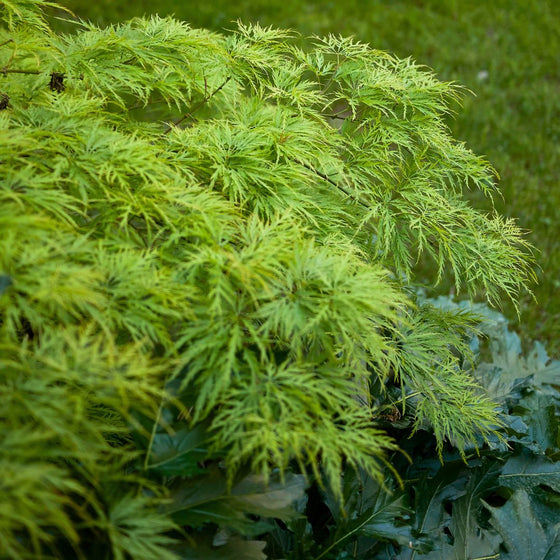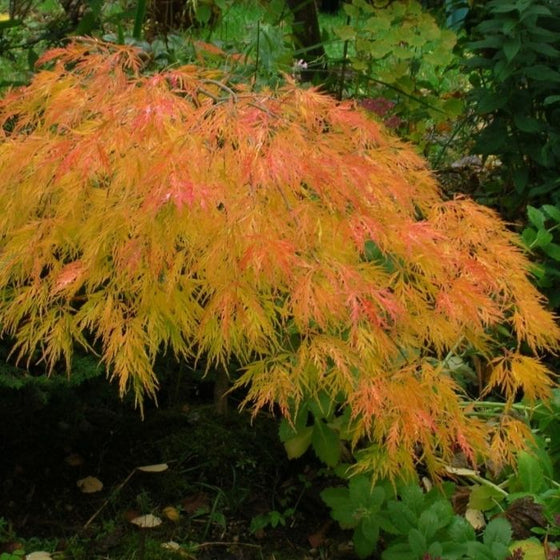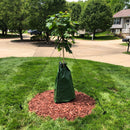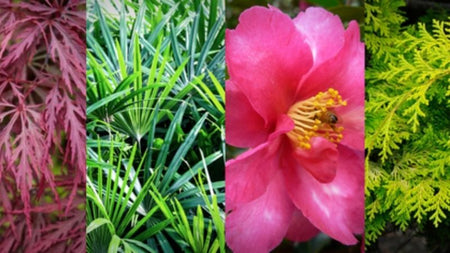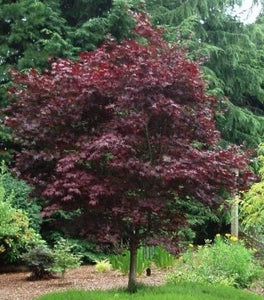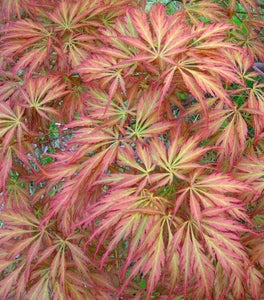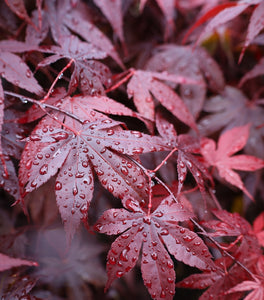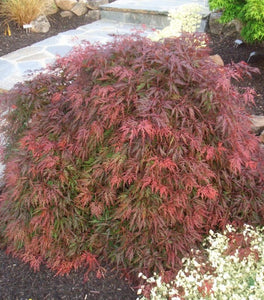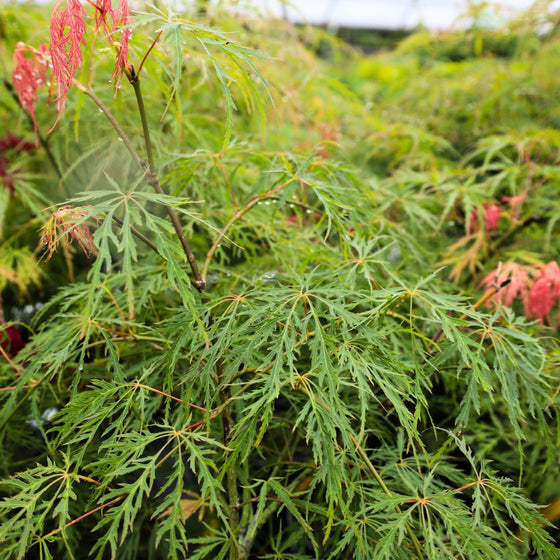
Images Depict Mature Plants
Waterfall Japanese Maple Trees
Waterfall Japanese Maple (Acer palmatum ‘Waterfall’) is a stunning weeping laceleaf variety prized for its cascading branches and lush, finely dissected green foliage. In spring and summer, the delicate leaves form a graceful, flowing canopy that resembles a waterfall of vibrant green. As autumn approaches, Waterfall transforms into a breathtaking display of golden yellow and fiery orange, creating a brilliant seasonal show. Growing to about 6 to 10 feet tall and wide, this slow-growing, compact tree is perfect for accentuating patios, pondsides, rock gardens, and serene Japanese-inspired landscapes.
Thriving best in partial sun to partial shade, Waterfall Japanese Maple prefers rich, well-drained soil with a slightly acidic pH to maintain its vibrant leaf color and healthy structure. Its naturally weeping habit and elegant branching make it a standout focal point, whether planted as a specimen tree or integrated into mixed borders and woodland gardens. Waterfall is also well-suited for container gardening, where its graceful form can be showcased up close on patios or decks. With minimal maintenance, regular watering, and protection from harsh afternoon sun, Waterfall will flourish and add timeless beauty to your outdoor spaces.
Ideal for creating peaceful, visually dynamic landscapes, Waterfall Japanese Maple brings year-round elegance, offering a soft, flowing texture that complements both naturalistic and formal garden designs. Its manageable size, vibrant fall color, and refined weeping structure make it a favorite choice among gardeners and landscape designers alike. Easy to grow and rewarding to care for, Waterfall will enhance your garden with grace, color, and movement for many years to come.
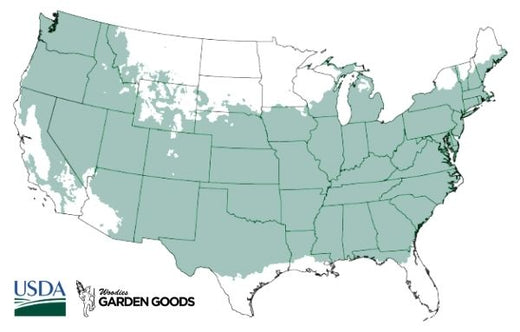
| Hardiness Zone: | 5-8 |
|---|---|
| Mature Height: | 8 to 10 feet |
| Mature Width: | 8 to 10 feet |
| Classification: | Small tree |
| Sunlight: | Part to full sun |
| Habit: | Deciduous, densely branched |
| Flower Color: | Insignificant |
| Foliage: | Green leaves turn golden in fall |
| Soil Condition: | Any well drained soil |
| Water Requirements: | Water well until established |
| Uses: | Extremely attractive when used as a focal point or a specimen planting, very slow growing |
How to Care for Waterfall Japanese Maple
Before you buy a Waterfall Japanese Maple Trees, make sure to read about the care instructions that are recommended to keep this plant healthy and thriving.
How Should I Plant My Waterfall Japanese Maple Tree?
To plant your Waterfall Japanese Maple tree successfully, choose a location with partial sun to partial shade, ideally offering morning light and afternoon protection. This lighting helps preserve the tree’s vibrant green foliage and prevents leaf scorch during hot summer months. Dig a hole twice as wide and just as deep as the root ball, making sure the crown of the tree sits slightly above ground level to encourage good drainage. Gently loosen the roots if they are circling the pot, position the tree carefully in the hole, and backfill with a mix of native soil and organic compost. Water thoroughly after planting to eliminate air pockets and help the soil settle securely around the roots. After planting your Waterfall Japanese Maple, apply a 2- to 3-inch layer of organic mulch, such as shredded bark or compost, around the base of the tree, keeping the mulch a few inches away from the trunk to prevent rot. Mulching helps maintain consistent soil moisture, regulate root temperature, and suppress weed growth. During the first growing season, water regularly to keep the soil evenly moist but not soggy. With proper site selection, planting technique, and aftercare, your Waterfall Japanese Maple will quickly establish itself as a stunning, flowing focal point that brings grace, color, and timeless beauty to your garden or landscape.
How Should I water My Waterfall Japanese Maple Tree?
Watering your Waterfall Japanese Maple correctly is essential for maintaining its lush, cascading foliage and vibrant health. During the first growing season, water deeply two to three times per week to ensure the soil remains consistently moist but never waterlogged. Deep watering encourages strong root development, which supports the tree’s graceful structure and brilliant seasonal color. Using a soaker hose or drip irrigation system helps deliver slow, steady moisture directly to the root zone, minimizing water waste and reducing the risk of fungal diseases from wet foliage. Once established, your Waterfall Japanese Maple will require less frequent watering but will still benefit from deep soaking during hot, dry periods, especially in the heat of summer. Always check the top few inches of soil; if it feels dry, it’s time to water. Applying a 2–3 inch layer of organic mulch around the base helps retain soil moisture, regulate soil temperature, and minimize evaporation. Proper, consistent watering ensures that your Waterfall Japanese Maple thrives with vibrant green foliage in spring and summer and transforms into a breathtaking display of golden-yellow and orange in the fall.
How Should I Fertilize My Waterfall Japanese Maple Tree?
Fertilizing your Waterfall Japanese Maple tree properly is key to supporting its lush cascading foliage, steady growth, and brilliant fall color display. In early spring, before new leaves emerge, apply a slow-release, balanced fertilizer such as a 10-10-10 formula or one specifically designed for trees and shrubs. Spread the fertilizer evenly around the drip line, several inches away from the trunk, and water thoroughly to help nutrients absorb into the soil. Avoid high-nitrogen fertilizers, which can promote excessive, weak growth that may spoil the tree’s elegant, weeping form and delicate leaf structure. For ongoing health, you may choose to lightly fertilize again in mid-summer, especially if your Waterfall Japanese Maple is planted in sandy or nutrient-poor soil. Alternatively, using organic options like composted bark, leaf mulch, or well-aged manure helps maintain a rich, slightly acidic soil environment that Japanese maples love. Always be cautious not to over-fertilize, as this can stress the tree and diminish its natural beauty. With thoughtful, moderate fertilization, your Waterfall Japanese Maple will thrive, displaying vibrant green foliage in spring and summer, and transforming into a cascade of golden-yellow and orange brilliance in the fall.

How and When Should I Prune My Waterfall Japanese Maple Tree?
Pruning your Waterfall Japanese Maple should be done carefully to maintain its natural, graceful, cascading form and to promote healthy growth. The best time to prune is in late winter to early spring, before new leaves begin to emerge but after the threat of severe frost has passed. Begin by removing any dead, damaged, or crossing branches using clean, sharp pruning shears. Lightly thinning the interior helps improve air circulation and allows more sunlight to reach the inner canopy, which enhances the tree’s overall health and reduces the risk of fungal diseases. Always make cuts just above a bud or branch junction to encourage healthy regrowth. You can also perform light touch-up pruning during early summer once the leaves have fully expanded, allowing you to fine-tune the tree’s flowing shape without causing stress. Avoid heavy pruning late in the growing season, as it can encourage tender new growth that may not harden off before winter. When pruning your Waterfall Japanese Maple, the goal is to enhance its natural, weeping habit rather than drastically altering its form. With careful, minimal pruning each year, your Waterfall will continue to showcase its stunning cascading branches and breathtaking seasonal color, making it a showpiece in your garden for years to come.

